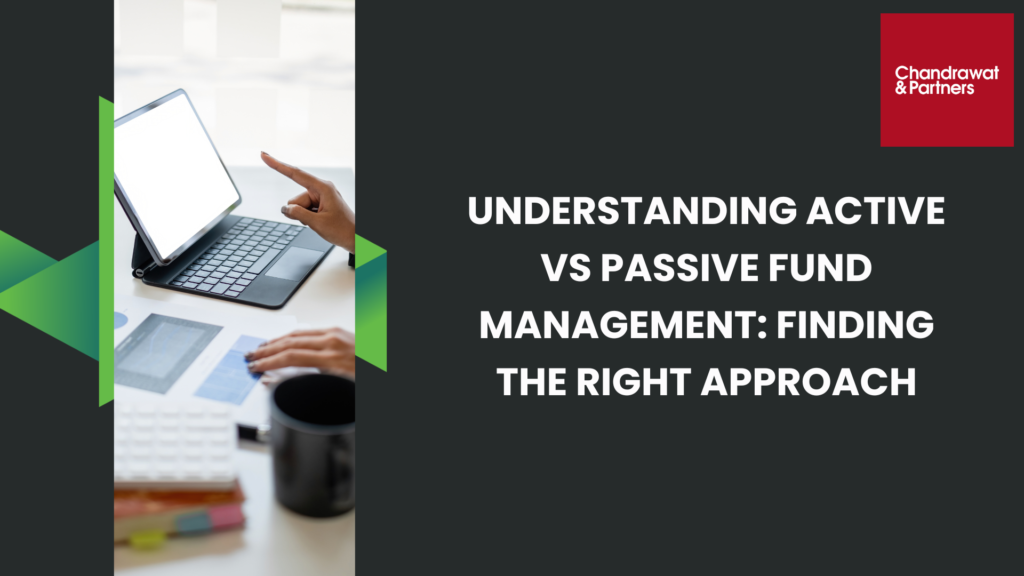Edit Content
Edit Content
Edit Content

Active versus passive fund management are two separate strategies in the field of investment management that have caused heated discussions among financial professionals. Since each strategy has advantages and disadvantages of its own, investors need to comprehend the key distinctions between them.
Active managers take a direct approach, continuously monitoring market movements and selecting investments based on their knowledge. Further the point; how taking advantage of opportunities and quickly responding to shifting market circumstances may help active fund management potentially exceed market indexes and how active managers’ ability for thorough research helps them to find undervalued assets that could produce better returns.
Instead of actively choosing individual assets, passive managers aim to imitate a certain index. Despite having lower expense ratios than their actively managed equivalents, passive funds have several restrictions. That how the incapacity of passive investment to respond fast or profit from passing market inefficiencies can lead to missed opportunities for higher profits.
It seeks to provide with a thorough grasp of the benefits and drawbacks of both active and passive fund management by covering both sides of the argument. Investors seeking the best performance from their portfolios while taking their risk tolerance and long-term objectives into account must ultimately strike the correct mix between active and passive techniques. Individuals may distribute their money wisely in an ever-changing financial environment by carefully analysing these considerations.
Investors can benefit from active fund management in several ways. First, active fund managers can investigate and evaluate investment possibilities actively, which may enable them to spot undervalued assets and provide greater returns. Active managers can profit from short-term market inefficiencies that passive funds might ignore by closely checking market developments and doing in-depth analysis. Active managers may immediately change their portfolios thanks to this proactive strategy, maximising potential gains and minimising losses.
As well active fund management gives investors the chance to gain from the knowledge and experience of qualified portfolio managers. These people have a thorough understanding of multiple asset classes and may use that information to build well-diversified portfolios that are suited to certain investing objectives. Their comprehensive research capabilities allow them to spot developing trends or market segments with development potential before the market takes notice.
Additionally, active fund management gives investors more flexibility in how they react to shifting market conditions. Active managers have the freedom to vary from their benchmarks if they feel it is important for optimising returns or controlling risks, unlike passive funds that seek to copy a benchmark index. When markets are volatile, or the economy is unclear, passive funds may be obliged to keep underperforming assets because of their fixed composition. During these times, this flexibility is especially important.
Furthermore, some investors like the feeling of control that active fund management offers. Investors feel more involved in the decision-making process when they actively choose assets based on their own risk tolerance and financial goals rather than depending on the pre-determined index allocation utilised by passive funds. Investors can use this feature to match their portfolios to their ideals or certain investment philosophies, such as thematic investing or socially responsible investing.
Also active fund management has the potential to offer downside protection during weak markets or economic downturns. When active managers foresee unfavourable market circumstances, they might use a variety of defensive tactics, including raising cash holdings or changing allocations into less volatile sectors. The objective of this proactive risk management strategy is to protect capital and reduce losses during turbulent times.
Investors can profit from active fund management in several ways. Active funds have several advantages over passive ones, including the ability to actively seek for and evaluate investment possibilities, leverage professional portfolio manager’s knowledge, react quickly to shifting market circumstances, provide investors with a sense of control and maybe provide downside protection. Although there are justifiable reasons in favour of passive fund management as well, investors must understand the advantages and disadvantages of each strategy to make decisions that are appropriate for their particular investment objectives and risk tolerance.
Despite growing in prominence in recent years, passive fund management has several disadvantages. The rigidity of passive techniques is one of its main drawbacks. These fund’s holdings are decided by the index’s makeup because they are meant to track a particular index. As a result, passive managers have little influence over the securities they hold and are unable to make changes in response to changes in the market or the performance of particular companies. As a result, investors who choose passive funds can pass up chances to beat the market or safeguard their money during market downturns.
The incapacity of passive fund management to actively look for inexpensive or attractive investments is another drawback. Passive managers merely copy the holdings of a certain index, as opposed to active managers who perform considerable research and analysis to find appealing possibilities. They lose the potential rewards associated with the expert stock selection and market timing techniques used by active managers by doing.
Additionally, although while passive funds are sometimes praised for charging lower fees than actively managed funds, this cost advantage might be misleading. Due to their hands-off management style, passive funds do tend to have lower expense ratios, but there may be other charges that investors don’t realise, such as monitoring mistakes and turnover costs. When a fund’s performance deviates from its benchmark owing to faulty replication or different fees, this is referred to as a tracking error. Transaction fees spent while rebalancing a portfolio’s holdings to reflect changes in an index’s composition are referred to as turnover expenditures. Over time, these extra expenses may reduce investor returns and lessen the perceived cost advantage of passively managed funds.
The possible effects of herd behaviour on passive investment techniques must also be considered. There is a chance of asset price distortion and decreased market efficiency as more investors go towards well-liked index-tracking funds. Certain stocks may become overpriced while others may stay underestimated when buying choices are purely based on an index’s composition rather than the specific business fundamentals or valuation measures. As a result, there may be market mispricing, which might result in bubbles or market inefficiencies.
Although passive fund management has been increasingly popular recently, it is crucial to understand its limitations and potential drawbacks. When choosing between active and passive investing techniques, investors should carefully examine the lack of flexibility, the absence of active stock selection, hidden expenses, and the possibility of herd behaviour. In a market environment that is always shifting, finding a balanced approach that combines components of both may be the key to optimising investment results.
In conclusion, for investors to make wise choices about their investment plans, it is essential to understand the distinctions between active and passive fund management. Before selecting the best strategy, it is important to thoroughly weigh the advantages and disadvantages of each approach.
The advantages of active fund management include its ability to outperform the market and produce greater returns. Actively analysing market trends, spotting undervalued assets, and making necessary portfolio adjustments are all skills that fund managers possess. They can take advantage of possibilities that might not be accessible through passive investment thanks to their flexibility. Additionally, for investors who prefer a more direct approach, active management offers a sense of control and customisation.
For more information or queries, please email us at
[email protected]

Managing Partner
Copyright © Chandrawat & Partners. All Rights Reserved.
Copyright © Chandrawat & Partners. All Rights Reserved.

Chandrawat & Partners stands as a dynamic and rapidly expanding full-service firm, specializing in the delivery of exceptional professional and corporate services to a diverse clientele, both foreign and local. We proudly represent companies and individuals across a wide spectrum of sectors through distinct entities established in various countries worldwide.
ASIA
AFRICA
EUROPE
NORTH AMERICA
SOUTH AMERICA
OCEANIA
Chandrawat & Partners uses cookies to run our site and improve its usability.
By using our site you agree to our use of Cookies.